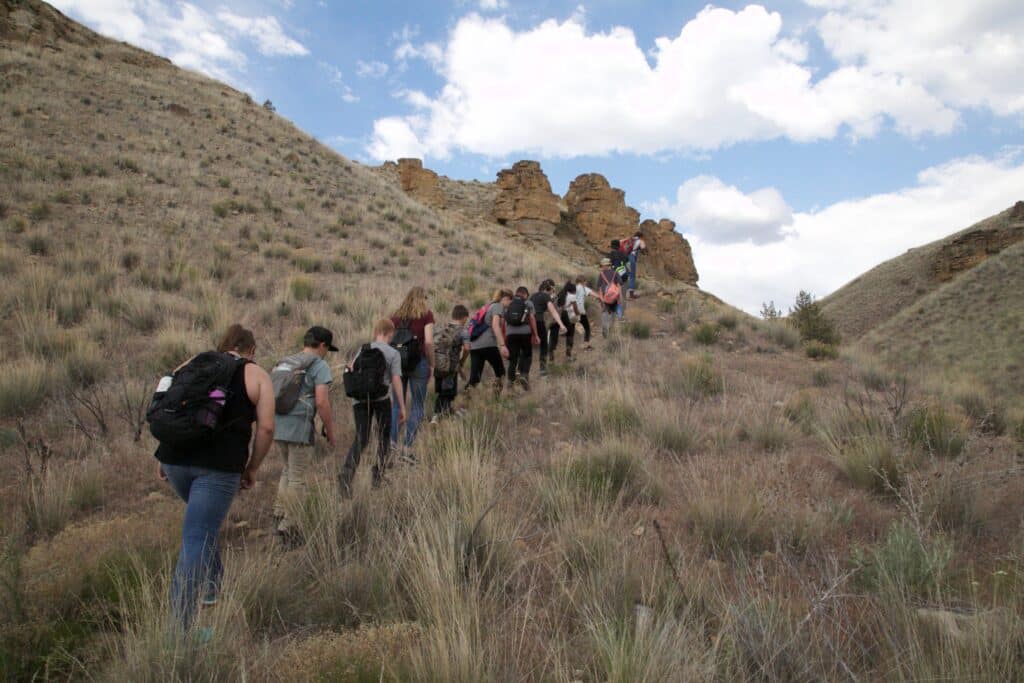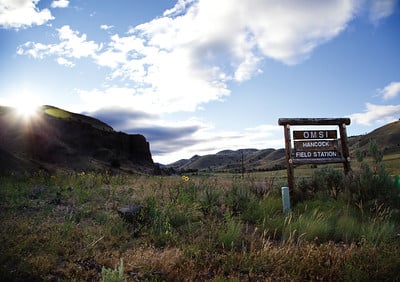Explore Hancock Field Station
Rustic, Yet Well-Equipped
Camp Hancock is a small rustic camp nestled in a charming little valley near Clarno, Oregon. Our facility is remote, serene, rustic, and peaceful. Cell phones won’t work out here; however, we have WiFi. The amenities at Hancock are well-cared for and well-used. Our top priorities are safety, fun, and respect for ourselves, each other, and the environment.
Camp Tour
Welcome to Hancock
Located on Highway 218 in Wheeler County, Oregon, our rustic and historic camp is uniquely situated within the boundaries of the John Day Fossil Beds National Monument, Clarno Unit.
Cabin Time in the Desert
We have three different sizes of cabins. Some have six bunks (twelve beds), others have four bunks (eight beds), and the smallest have three beds. All cabins have twin mattresses, doors and/or windows, electricity, and small heaters, and the large cabins have padded cement floors. The restrooms are a short walk from the cabins.
Where We Eat
Campers and staff eat “family-style” meals together in Berrie Hall. We take pride in serving meals that are nutritious and homemade. We offer a supplemental salad/cereal/fruit bar at each meal and can accommodate food allergies and dietary restrictions.
Restrooms and Showers
The restrooms are a short walk from the cabins. They have hot and cold running water, toilets, showers, heat, and electricity. Each cabin area has a restroom/shower facility nearby, and our new North Restroom is accessible and gender-inclusive, featuring individual lockable rooms.
Where Learning and Adventure Meet
Everyone deserves to learn in a safe, respectful, kind, and inclusive community. We weave themes of adventure, science, exploration, and community into daily life and use an experiential, concept-based style of teaching that is effective, nurturing, inspiring, and memorable.
Recreation and Free Play
Volleyball, tetherball, basketball, reading, games, music, and arts and crafts are just a few of our choices for recreation.
Central Meeting Space
Games, campfire, orientation, classes, lunch, and relaxation time are just a few of the times we utilize our most common meeting place: The Bleachers!
The Land Where We Live, Work + Play
Let us remember, honor, and acknowledge the spiritual connection Indigenous people have to the land and how historically their traditional knowledge has been excluded from the scientific community that OMSI participates in and contributes to.
Hancock Field Station occupies the traditional homelands of the Tenino (tuh·ni·now), the Northern Paiute (pie·yoot), and many other tribes (federally recognized or not); many of whom are now part of the Confederated Tribes of Warm Springs.
Maps and Local Info
Access + Inclusion
You are Welcome Here
OMSI Equity Statement: “OMSI respects, values, and celebrates the unique attributes, characteristics, and perspectives that make each person who they are. We believe that we will be successful in accomplishing our mission and vision when we seek out and respond to diversity of participation, thought, and action. We will work to dismantle barriers to equity and access to the experiences OMSI provides and to create welcoming environments and conditions where all people can reach their full potential. We lead with race.”
With open hearts and open minds, we strive to create inclusive spaces where you can be your authentic self. We provide training and professional development to our staff on equity and inclusion principles and training in mental health first aid.
We are proud to have consulted with TransActive in Portland, Empowering Access out of Bend, and many others to improve our facility. Our goal is increased access and mobility around camp. Admittedly, we have a long way to go! We are always open to learning, listening, finding creative solutions to problems, and creating meaningful change. The facility is not currently wheelchair accessible; the camp is built on an incline, and our main camp is mostly gravel. The trails are uneven, rocky, and hikes can gain some elevation, ranging from easy to moderate. Please reach out to us if you have any questions regarding accessibility and inclusion.
Yes! We can, and we have successfully done so.
As is traditional in residential overnight camps, our site was designed to accommodate binary gender divisions in our living, restroom, and shower facilities. We realize our existing sleeping and hygiene areas present obstacles for the gender diverse and we are committed to respectfully minimizing those obstacles. Since each individual is different and has different needs, we encourage you to reach out if you have any specific questions or concerns. We appreciate any opportunity to speak directly with families about how we can work together to make the OMSI summer camp experience worry-free for everyone regardless of orientation, gender, or any other identity.
Camp Hancock was built on a slight incline, and the terrain is uneven and rocky. We have an ADA-accessible cabin and restroom, and we are working towards incorporating wheelchair accessible paths throughout. Currently the grounds are covered with gravel to keep the dust and dirt at bay. We will work with group leaders and families to choose programs that will best meet the needs of all participants.
Offsite trails on the John Day Fossil Beds National Monument are also uneven and rocky, with a mix of easy to moderate hikes. Many hikes gain elevation, and can be anywhere from half a mile to three miles long. We are able to tailor which trails are used to accommodate the group. We tend to focus on ecological concepts, so any path chosen will be a rich experience for everyone.
Camp Hancock is not a place for pets. Service animals are permitted in all areas where guests are allowed. In keeping with the Americans with Disabilities Act, a service animal is defined as a dog that is trained to do work or perform tasks for the benefit of an individual with a disability (providing emotional support or deterring crime are not considered qualifying tasks). Except under special conditions, service animals must be restrained while at Camp Hancock.
Parking a travel trailer, mobile home, or RV on property needs to be approved in advance by the site manager. Contact us if you are interested in exploring that option, and we’ll be happy to talk through it.
Camp History
Camp Hancock is owned and operated by the Oregon Museum of Science and Industry (OMSI). Since 1951, instruction has been offered in geology, paleontology, and related science fields.
The Early Days
Hancock Field Station was named for Alonso “Lon” W. Hancock, an amateur paleontologist who received national attention in 1942 when he discovered a vertebrate fossil – a rhinoceros tooth – in the Eocene-age Clarno formation near the site of the present-day Hancock Field Station. He went on to unearth many other vertebrate fossils in the area, from alligators to prehistoric camels to three-toed horses.
Berrie Hall
Along with countless friends, scientists, and volunteers, Lon and Berrie Hancock spent many summers leading students on fossil expeditions in the Clarno area. Lon passed away in 1961. However, his legacy lives on almost 75 years later.
Camp Hancock as a Tent Camp
In 1951, the Hancocks took fourteen campers and a volunteer staff for the first twelve-day summer camp under OMSI sponsorship. Dedicated leaders and scientists like Murray Miller, Pete Meierjurgen, Tom Bones, Larry Abney, John Armentrout, and many others paved the way and shaped what Hancock is today.
Camp Hancock Takes Shape
In the 1960s and 1970s, dedicated leaders and scientists hosted many volunteer work parties to build cabins and classrooms. OMSI was leasing the land at the time. In 1975, President Ford designated the national monument, and in 1984, the deed to the 10-acre property within was given to OMSI. Hancock Field Station has grown from a tent camp into a modern, well-equipped environmental science education facility. Hancock Field Station welcomes about 3,000 guests annually.
Staffing the Remote Facility
In 1976, a director’s home was donated, and in the 1990s, the Washington Family auctioned off small A-Frames that were once on the Rajneesh compound. OMSI bought many, and the arduous task of transporting the buildings over the rough terrain began. These additional buildings allowed staff members to reside at the camp seasonally and full-time.
Where We Are Now
Some buildings might show their age, but we have a dedicated maintenance and administrative staff to keep them in good repair. In 2019, a master plan was drawn, and the renovation of the North Restroom in 2021 catapulted Hancock into more modern times. These are two steps towards updating the other camp buildings and improving accessibility at Camp Hancock. As time and budget allow, we’ll continue improving upon what Lon, Berrie, and all their friends and colleagues started.
Visit Camp Gray
Looking for waves and sea lions? Check out our other camp for more outdoor school and summer camp opportunities!

